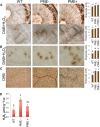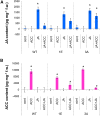Defense Responses in Aspen with Altered Pectin Methylesterase Activity Reveal the Hormonal Inducers of Tyloses
- PMID: 27923986
- PMCID: PMC5291032
- DOI: 10.1104/pp.16.01443
Defense Responses in Aspen with Altered Pectin Methylesterase Activity Reveal the Hormonal Inducers of Tyloses
Abstract
Tyloses are ingrowths of parenchyma cells into the lumen of embolized xylem vessels, thereby protecting the remaining xylem from pathogens. They are found in heartwood, sapwood, and in abscission zones and can be induced by various stresses, but their molecular triggers are unknown. Here, we report that down-regulation of PECTIN METHYLESTERASE1 (PtxtPME1) in aspen (Populus tremula × tremuloides) triggers the formation of tyloses and activation of oxidative stress. We tested whether any of the oxidative stress-related hormones could induce tyloses in intact plantlets grown in sterile culture. Jasmonates, including jasmonic acid (JA) and methyl jasmonate, induced the formation of tyloses, whereas treatments with salicylic acid (SA) and 1-aminocyclopropane-1-carboxylic acid (ACC) were ineffective. SA abolished the induction of tyloses by JA, whereas ACC was synergistic with JA. The ability of ACC to stimulate tyloses formation when combined with JA depended on ethylene (ET) signaling, as shown by a decrease in the response in ET-insensitive plants. Measurements of internal ACC and JA concentrations in wild-type and ET-insensitive plants treated simultaneously with these two compounds indicated that ACC and JA regulate each other's concentration in an ET-dependent manner. The findings indicate that jasmonates acting synergistically with ethylene are the key molecular triggers of tyloses.
© 2017 American Society of Plant Biologists. All Rights Reserved.
Figures






Similar articles
-
OsEDR1 negatively regulates rice bacterial resistance via activation of ethylene biosynthesis.Plant Cell Environ. 2011 Feb;34(2):179-91. doi: 10.1111/j.1365-3040.2010.02219.x. Epub 2010 Oct 29. Plant Cell Environ. 2011. PMID: 20807375
-
Jasmonic Acid- and Ethylene-Induced Mitochondrial Alternative Oxidase Stimulates Marssonina brunnea Defense in Poplar.Plant Cell Physiol. 2021 Feb 4;61(12):2031-2042. doi: 10.1093/pcp/pcaa117. Plant Cell Physiol. 2021. PMID: 32946565
-
Ethylene and jasmonic acid act as negative modulators during mutualistic symbiosis between Laccaria bicolor and Populus roots.New Phytol. 2014 Apr;202(1):270-286. doi: 10.1111/nph.12655. Epub 2014 Jan 3. New Phytol. 2014. PMID: 24383411
-
SA, JA, ethylene, and disease resistance in plants.Curr Opin Plant Biol. 1998 Aug;1(4):316-23. doi: 10.1016/1369-5266(88)80053-0. Curr Opin Plant Biol. 1998. PMID: 10066607 Review.
-
Jasmonate- and salicylate-mediated plant defense responses to insect herbivores, pathogens and parasitic plants.Pest Manag Sci. 2009 May;65(5):497-503. doi: 10.1002/ps.1714. Pest Manag Sci. 2009. PMID: 19206090 Review.
Cited by
-
The RPN12a proteasome subunit is essential for the multiple hormonal homeostasis controlling the progression of leaf senescence.Commun Biol. 2022 Sep 30;5(1):1043. doi: 10.1038/s42003-022-03998-2. Commun Biol. 2022. PMID: 36180574 Free PMC article.
-
How plants manage pathogen infection.EMBO Rep. 2024 Jan;25(1):31-44. doi: 10.1038/s44319-023-00023-3. Epub 2023 Dec 19. EMBO Rep. 2024. PMID: 38177909 Free PMC article. Review.
-
Ring-specific vulnerability to embolism reveals accumulation of damage in the xylem.New Phytol. 2025 Jun;246(5):2046-2058. doi: 10.1111/nph.70137. Epub 2025 Apr 18. New Phytol. 2025. PMID: 40247814 Free PMC article.
-
Physiological Analysis and Transcriptome Profiling of Inverted Cuttings of Populus yunnanensis Reveal That Cell Wall Metabolism Plays a Crucial Role in Responding to Inversion.Genes (Basel). 2018 Nov 23;9(12):572. doi: 10.3390/genes9120572. Genes (Basel). 2018. PMID: 30477186 Free PMC article.
-
Comparative physiological, biochemical, metabolomic, and transcriptomic analyses reveal the formation mechanism of heartwood for Acacia melanoxylon.BMC Plant Biol. 2024 Apr 22;24(1):308. doi: 10.1186/s12870-024-04884-1. BMC Plant Biol. 2024. PMID: 38644502 Free PMC article. Review.
References
-
- Babst BA, Sjödin A, Jansson S, Orians CM (2009) Local and systemic transcriptome responses to herbivory and jasmonic acid in Populus. Tree Genet Genomes 5: 459–474
-
- Bamber RK. (1976) Heartwood, its function and formation. Wood Sci Technol 10: 1–8
-
- Berthold F, Mellerowicz E, Sundberg BW (2006) New transgenic plants and method of their production. Patent No. WO2006/068603-A1
Publication types
MeSH terms
Substances
LinkOut - more resources
Full Text Sources
Other Literature Sources

